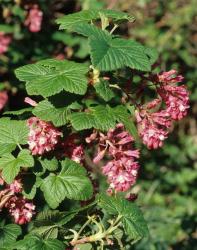- Taxon
- Weed
- Gallery
Unarmed, deciduous, moderately aromatic shrub, 1–2–(3) m high; branches and shoots erect, tomentulose or glandular hairy when young. Lvs plicately folded in bud, with petioles to c. 8 cm long, slightly clasping at base; lamina very broadly ovate or deltoid, (3)–4–8–(10) × (3.5)–4–9–(10) cm, often smaller on upper part of flowering stems, deeply palmately-lobed, with 3–5 broadly ovate, coarsely serrate lobes, glabrate or hairy, dull, somewhat rugose with impressed veins above, glabrate to hairy or sometimes tomentose below, sparsely to densely covered with almost colourless, inconspicuous glandular scales; base subcordate to deeply cordate. Racemes pendent, usually 15-many-flowered; fls not fragrant. Hypanthium 4–7 mm long, cylindric, pale pink to deep red, with scattered simple eglandular or glandular hairs. Sepals 4–6.5 mm long, ± elliptic-oblong, pale pink to deep red, glabrous or with simple or glandular hairs, reflexed at anthesis. Petals 3–5 mm long, spathulate or obovate, white ageing pink to rose. Filaments 1–2.5 mm long. Fr. 5–7 mm diam., globose, black, opaque and usually with a whitish bloom, ± glandular; flesh with little taste.
[From: Webb et al. (1988) Flora of New Zealand. Volume 4.]
| Category | Number |
|---|---|
| Exotic: Casual | 1 |
| Total | 1 |
Flowering: Aug.–Nov.; Fruiting: Nov.–Mar.




